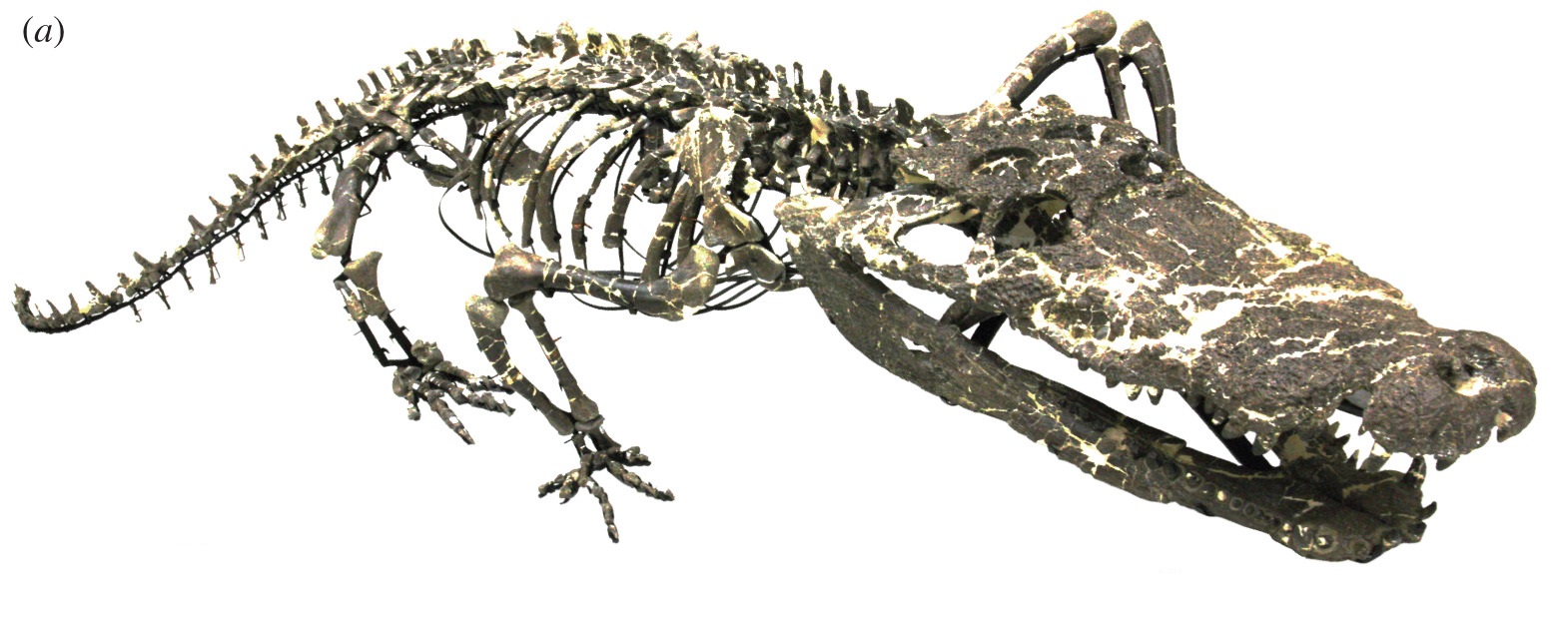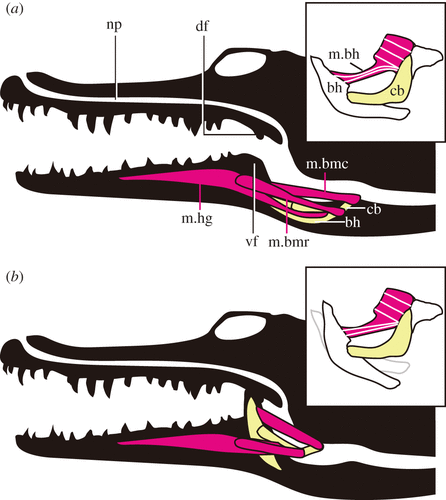Amphicotylus Milesi on:
[Wikipedia]
[Google]
[Amazon]
''Amphicotylus'' is an
 In the 1930s the Works Progress Administration discovered further remains in Oklahoma which were initially investigated by J. W. Stovall, noting similarities to ''Amphicotylus gilmorei''. The remains were officially described by Mook in 1964 as a species of ''
In the 1930s the Works Progress Administration discovered further remains in Oklahoma which were initially investigated by J. W. Stovall, noting similarities to ''Amphicotylus gilmorei''. The remains were officially described by Mook in 1964 as a species of ''
 The anatomy of the palate and hyoid in ''A. milesi'' show similar adaptations to extant crocodilians, with the anterior portion of the elongated choana possibly being covered in soft tissue similar to the state observed in embryos of American alligators. Based on the morphology of the hyoid apparatus and its muscle attachments, ''A. milesi'' would have been able to raise the ventral fold of the gullar valve, separating narial and oral passages. This adaptation for semi-aquatic life would have allowed ''Amphicotylus'' and other Neosuchians to completely cut out the oral cavity from respiration, giving it the ability to open its mouth underwater while continuing to breathe as long as the nares are above the surface. This pushes the development of a crocodilian-like respiratory system to the beginnings of Neosuchian evolution in the Jurassic period.
The anatomy of the palate and hyoid in ''A. milesi'' show similar adaptations to extant crocodilians, with the anterior portion of the elongated choana possibly being covered in soft tissue similar to the state observed in embryos of American alligators. Based on the morphology of the hyoid apparatus and its muscle attachments, ''A. milesi'' would have been able to raise the ventral fold of the gullar valve, separating narial and oral passages. This adaptation for semi-aquatic life would have allowed ''Amphicotylus'' and other Neosuchians to completely cut out the oral cavity from respiration, giving it the ability to open its mouth underwater while continuing to breathe as long as the nares are above the surface. This pushes the development of a crocodilian-like respiratory system to the beginnings of Neosuchian evolution in the Jurassic period.
extinct
Extinction is the termination of an organism by the death of its Endling, last member. A taxon may become Functional extinction, functionally extinct before the death of its last member if it loses the capacity to Reproduction, reproduce and ...
genus
Genus (; : genera ) is a taxonomic rank above species and below family (taxonomy), family as used in the biological classification of extant taxon, living and fossil organisms as well as Virus classification#ICTV classification, viruses. In bino ...
of goniopholidid
Goniopholididae is an extinct family of moderate-sized semi-aquatic neosuchian crocodyliformes. Their bodyplan and morphology are convergent on living crocodilians. They lived across Laurasia (Asia, Europe and North America) between the Middle J ...
mesoeucrocodylia
Mesoeucrocodylia is the clade that includes Eusuchia and crocodyliforms formerly placed in the paraphyletic group Mesosuchia. The group appeared during the Early Jurassic, and continues to the present day.
Diagnosis
It was long known that Me ...
n from the Tithonian
In the geological timescale, the Tithonian is the latest age (geology), age of the Late Jurassic Epoch and the uppermost stage (stratigraphy), stage of the Upper Jurassic Series. It spans the time between 149.2 ±0.7 annum, Ma and 143.1 ±0.6 (mi ...
of Colorado
Colorado is a U.S. state, state in the Western United States. It is one of the Mountain states, sharing the Four Corners region with Arizona, New Mexico, and Utah. It is also bordered by Wyoming to the north, Nebraska to the northeast, Kansas ...
, Wyoming
Wyoming ( ) is a landlocked U.S. state, state in the Mountain states, Mountain West subregion of the Western United States, Western United States. It borders Montana to the north and northwest, South Dakota and Nebraska to the east, Idaho t ...
, and Oklahoma
Oklahoma ( ; Choctaw language, Choctaw: , ) is a landlocked U.S. state, state in the South Central United States, South Central region of the United States. It borders Texas to the south and west, Kansas to the north, Missouri to the northea ...
. It was described in 1878.E. D. Cope. 1878. Descriptions of new extinct Vertebrata from the Upper Tertiary and Dakota Formations. 'Bulletin of the United States Geological and Geographical Survey of the Territories'', 4(2):379-396
Discovery and species
''Amphicotylus'' was first described byEdward Drinker Cope
Edward Drinker Cope (July 28, 1840 – April 12, 1897) was an American zoologist, paleontology, paleontologist, comparative anatomy, comparative anatomist, herpetology, herpetologist, and ichthyology, ichthyologist. Born to a wealthy Quaker fam ...
in 1878 based on dorsal and lumbar vertebrae, ribs and osteoderms. Based on these remains, found in the same locality as ''Camarasaurus supremus'', Cope determined the animal to have been smaller than the extant American Alligator and named the species ''A. lucasii'' after Superintendent Lucas who initially made the discovery. Cope also collected skull material from the same locality and level, however did not refer it to ''Amphicotylus''. The cranial material was examined by Charles C. Mook in 1942 who referred it to the type species not only on the basis of its locality, but also its matching size, general morphological characters and the absence of any other crocodilian remains from the area. Mook furthermore uses this skull to establish a provisional neotype
In biology, a type is a particular specimen (or in some cases a group of specimens) of an organism to which the scientific name of that organism is formally associated. In other words, a type is an example that serves to anchor or centralizes ...
to account for the fragmentary nature of the original material described by Cope.
 In the 1930s the Works Progress Administration discovered further remains in Oklahoma which were initially investigated by J. W. Stovall, noting similarities to ''Amphicotylus gilmorei''. The remains were officially described by Mook in 1964 as a species of ''
In the 1930s the Works Progress Administration discovered further remains in Oklahoma which were initially investigated by J. W. Stovall, noting similarities to ''Amphicotylus gilmorei''. The remains were officially described by Mook in 1964 as a species of ''Goniopholis
''Goniopholis'' (meaning "angled scale") is an extinct genus of goniopholidid crocodyliform that lived in Europe and North America during the Late Jurassic and Early Cretaceous. Like other goniopholidids, it resembled living crocodilians, and pro ...
'', ''Goniopholis stovalli''. In 2012 Eric Randall Allen argued that the goniopholidids found in the Morrison Formation
The Morrison Formation is a distinctive sequence of Upper Jurassic sedimentary rock found in the western United States which has been the most fertile source of dinosaur fossils in North America. It is composed of mudstone, sandstone, siltston ...
differ significantly from their European counterparts in the anatomy of the palate, with the choanae fully splitting the palatines unlike in the taxa from the UK and mainland Europe. Consequently, Allen reasons that ''Goniopholis'' should exclusively refer to European forms while ''Amphicotylus'' should serve as a constituent for Morrison goniopholidids previously referred to ''Goniopholis'', such as ''"Goniopholis" felix''. Furthermore, it is noted that there are no significant differences between ''A. lucasii'' and the only known material of ''A. gilmorei'', with the only notable morphological character being artificially created by breakage, rendering it a junior synonym of the genus' type species.
Excavations in the East Camarasaurus Quarry, Wyoming, in 1993 yielded the largest and most complete goniopholidid skeleton found to date. Since 1996 the fossil has been exhibited and stored in the Gunma Museum of Natural History
is a museum of the natural sciences in Tomioka, Gunma, Tomioka, Gunma Prefecture, Japan.
History
The museum first opened in 1978 under its old Japanese name, after repairs to the former . In 1996, the old museum closed, and its collection was tra ...
in Japan
Japan is an island country in East Asia. Located in the Pacific Ocean off the northeast coast of the Asia, Asian mainland, it is bordered on the west by the Sea of Japan and extends from the Sea of Okhotsk in the north to the East China Sea ...
before it was described by Yoshida ''et al.'' in 2021 as ''Amphicotylus milesi'', in honor of Clifford Miles for his contribution to the excavation and museum curation.
Description
''Amphicotylus'' had a roughly triangular, platyrostral skull similar in shape to that of modern crocodilians. They differ from European goniopholidids in several morphological characters, most notably the anatomy of the palate. In members of ''Amphicotylus'', the palatines are completely separated from one another by the choana while in ''Goniopholis'' the palatines make broad contact prior to the choana. This trait is shared by '' Eutretauranosuchus''. ''Amphicotylus milesi'' is the largest species with a skull length of 43 cm. The anatomy of the palate and hyoid in ''A. milesi'' show similar adaptations to extant crocodilians, with the anterior portion of the elongated choana possibly being covered in soft tissue similar to the state observed in embryos of American alligators. Based on the morphology of the hyoid apparatus and its muscle attachments, ''A. milesi'' would have been able to raise the ventral fold of the gullar valve, separating narial and oral passages. This adaptation for semi-aquatic life would have allowed ''Amphicotylus'' and other Neosuchians to completely cut out the oral cavity from respiration, giving it the ability to open its mouth underwater while continuing to breathe as long as the nares are above the surface. This pushes the development of a crocodilian-like respiratory system to the beginnings of Neosuchian evolution in the Jurassic period.
The anatomy of the palate and hyoid in ''A. milesi'' show similar adaptations to extant crocodilians, with the anterior portion of the elongated choana possibly being covered in soft tissue similar to the state observed in embryos of American alligators. Based on the morphology of the hyoid apparatus and its muscle attachments, ''A. milesi'' would have been able to raise the ventral fold of the gullar valve, separating narial and oral passages. This adaptation for semi-aquatic life would have allowed ''Amphicotylus'' and other Neosuchians to completely cut out the oral cavity from respiration, giving it the ability to open its mouth underwater while continuing to breathe as long as the nares are above the surface. This pushes the development of a crocodilian-like respiratory system to the beginnings of Neosuchian evolution in the Jurassic period.
Phylogeny
Studies have repeatedly found ''Amphicotylus'' to be nested deep within Goniopholididae, typically located just outside the clade that contains most European members of the group. ''Denazinosuchus'', a late Cretaceous member of Goniopholididae, was recovered as a sister taxon to ''Amphicotylus'' by Puértolas-Pascual ''et al.'' 2015, but as part of the "European clade" by Yoshida ''et al.'' 2021. Yoshida ''et al.'' also include ''Sunosuchus thailandicus'' without following the revisions by Martin ''et al.'' 2013 that found it to be a distinct genus of pholidosaurid, ''Chalawan thailandicus
''Chalawan'' (from ) is an extinct genus of pholidosaurid mesoeucrocodylian known from the Late Jurassic or Early Cretaceous Phu Kradung Formation of Nong Bua Lamphu Province, northeastern Thailand. It contains a single species, ''Chalawan tha ...
''.
The phylogenetic tree recovered by Yoshida ''et al.'' is depicted below.
References
{{Taxonbar, from=Q4748233 Goniopholididae Late Jurassic crocodylomorphs of North America Late Jurassic reptiles of North America Morrison fauna Fossil taxa described in 1878 Taxa named by Edward Drinker Cope Prehistoric pseudosuchian genera